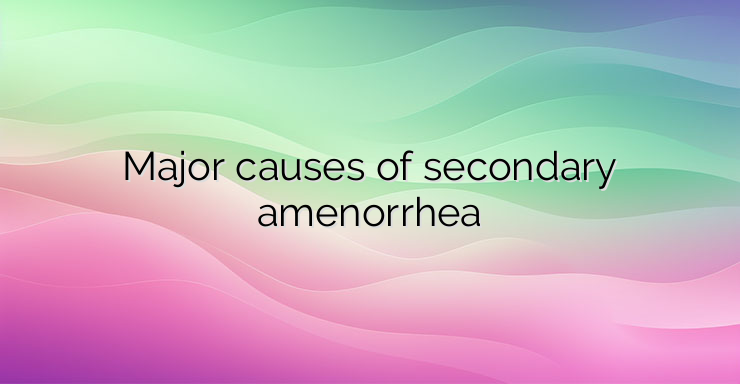The term amenorrhea refers to the absence of menstruation. Depending on whether menstruation was present or not before, amenorrhea is divided into two types: primary and secondary. Primary amenorrhea is the absence of menses among girls aged 16 years who have developed secondary genital markings or among girls aged 14 years without the development of secondary genital markings. Unlike primary menorrhoea, secondary menorrhoea is the absence of menstruation for a period of 6 or more months in the presence of a previous, normally occurring one. What are the most common causes of secondary amenorrhea and their treatment? The menstrual cycle, the duration of which is normally 28 ± 7 days, is under the hormonal control of the hypothalamic-pituitary-ovarian axis. Other endocrine glands also have an influence on menstruation, among which the thyroid occupies a major place. This is why maintaining optimal hormonal balance is essential for a woman’s reproductive health. 1. Pregnancy is the “most harmless” and first suspected cause of secondary amenorrhea of every gynecologist. Any patient complaining of months-long amenorrhea should take a pregnancy test to rule out or confirm one. Only when pregnancy is ruled out can one proceed to further diagnostic methods to establish the cause; 2. Lactation and menopause – two other physiological reasons for lack of menstruation. During breastfeeding, the production of the hormone prolactin is stimulated and the production of gonadotropin-releasing hormone is suppressed, as a result of which ovulation is suppressed – the so-called. Lactational amenorrhea; 3. Polycystic ovary syndrome (PCOS) – an increasingly common disease among young girls, a cause of amenorrhea. In PCOS, clinical or biochemical hyperandrogenism is observed, manifested by hirsutism, acne, alopecia; oligo- or amenorrhea; presence of multiple cysts in the ovaries; anovulation, etc.; 4. Disorders in the function of the thyroid gland – although it is not directly involved in the regulation of the menstrual cycle, the proper functioning of the thyroid gland is essential. It is necessary to examine the levels of the thyroid-stimulating hormone and the hormones of the thyroid gland – thyroxine and triiodothyronine, on the basis of which conditions of hypo- or hyperfunction of the gland are determined. Both hypo- and hyperthyroidism lead to menstrual disturbances and amenorrhea; 5. Prolactinoma – most often a benign formation of the pituitary gland, in which increased secretion of prolactin is observed. Hyperprolactinemia suppresses ovulation and causes amenorrhea; 6. Sheehan’s syndrome – the so-called empty saddle syndrome. It occurs with severe postpartum bleeding, in which the pituitary gland is ischemic and nectotized. Secretion along the hypothalamus-pituitary-ovary axis is disrupted and the result is secondary amenorrhea accompanied by numerous other complications; 7. Premature ovarian failure – a condition in which estrogen levels are low,and those of the follicle-stimulating hormone – high. The result of this hormonal imbalance is clinically apparent amenorrhea and infertility; 8. Asherman’s syndrome – intrauterine adhesions that lead to hypo- and amenorrhea. The main reason for the development of this syndrome are intrauterine manipulations such as dilatation and curettage; 9. Cushing’s syndrome – a syndrome in which there is an increased production of glucocorticoids. Amenorrhea in this case is due to the suppressed secretion of gonadotropic hormones, mainly luteinizing hormone; 10. Intense physical exertion, severe stress or anorexia nervosa – these conditions disturb the hormonal balance. The secretion of estrogens and luteinizing hormone decreases, as a result of which menstruation is absent. Finding the cause of secondary amenorrhea is not an easy task. It starts with a pregnancy test. In the case of a negative test, a complete examination of thyroid hormones, adrenal glands, and sex hormones is carried out. If a tumor of the hypothalamus or pituitary gland is suspected, a nuclear magnetic resonance or a head scan is performed. Ultrasound examination of a small pelvis, hysterosalpingography and hysteroscopy are important for diagnosis. The treatment of secondary amenorrhea depends on the cause leading to its appearance. In polycystic ovary syndrome, the treatment is a combination of lifestyle changes, treatment of insulin resistance and, depending on the patient’s reproductive wishes, hormone therapy. In case of prolactinoma, the treatment is operative. In Sheehan’s syndrome, hormone replacement therapy with all hormones produced by the pituitary gland is required. Regardless of the cause, the primary goal of any therapy is to restore menstruation.treatment of insulin resistance and depending on the reproductive wishes of the patient – hormone therapy. In case of prolactinoma, the treatment is operative. In Sheehan’s syndrome, hormone replacement therapy with all hormones produced by the pituitary gland is required. Regardless of the cause, the primary goal of any therapy is to restore menstruation.treatment of insulin resistance and depending on the reproductive wishes of the patient – hormonal therapy. In case of prolactinoma, the treatment is operative. In Sheehan’s syndrome, hormone replacement therapy with all hormones produced by the pituitary gland is required. Regardless of the cause, the primary goal of any therapy is to restore menstruation.


Leave a Reply